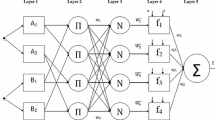Abstract
This letter presents a method for modelling and processing incomplete data in connectionist systems. The approach consists in applying a neuro-fuzzy coding to the input data of a neural network. After an introduction to the different kinds of imperfections, we propose a neuro-fuzzy coding in order to take incomplete data into account. We show the efficiency of this coding on the problem of the classification of seismic events. The results show that a neuro-fuzzy coding of the inputs of a neural network increases the performance and classifies incomplete data with little affect on the results.
Similar content being viewed by others
References
B. Bouchon-Meunier, La logique floue et ses applications, Addison-Wesley: Paris, France, 1995.
L.A. Zadeh, “Fuzzy sets as a basis for a theory of possibility”, Fuzzy sets and systems, No. 1, pp. 3–28, 1978.
P.J.B. Hancock, “Data representation in neural networks”, in Touretzky, Hinton, Sejnowski (eds) Proceeding of the 1988 Connectionist Models Summer School, pp. 11–20, Morgan Kaufmann: San Mateo, CA, 1988.
V. Lorquet, P. Puget, R. Guillemaud and J.J. Niez, “Improving half-distributed coding methods: a filtered process approach applied to data representation in neural nets”, in Kohonen, Makisara, Simula, Kangas (eds) Artificial Neural Networks, Elsevier Science Publishers B. V.: Helsinki, Finland, 1991.
S. Muller-Carceles and E. Moser, “Comparative Study of Vector Quantization Algorithms” (in French), Technical Report, INSTN, CEA-Univ. Paris XI, Orsay, France, 1995.
T. Martinetz, S. Berkovich and K. Shulten, “Neural-Gas network for vector quantization and its application to time-series prediction”, IEEE Transactions on Neural Network, Vol. 4, No. 4, pp. 558–569, 1993.
F.U. Dowla, S.R. Taylor and R.W. Andersen, “Seismic discrimination with artificial neural networks: preliminary results with regional spectral data”, Bulletin of Seismological Society of America, Vol. 80, No. 5, pp. 1346–1373, 1990.
J.J. Pulli and P.S. Dysart, “An experiment in the use of trained neural networks for regional seismic event classification”, Geophysical Research Letters, Vol. 17, pp. 977–980, American Geophysical Union: Washington, DC, 1990.
G.B. Patnaik, T.S. Sereno and R.D. Jenkins, “Test and evaluation of neural network applications for seismic signal discrimination”, Technical Report No. PL-TR–92–2218, Phillips Laboratory, San Diego, CA, 1992.
M. Musil and A. Plesinger, “Discrimination between local microearthquakes and quarry blasts by multi-layer perceptrons and Kohonen maps”, Bulletin of Seismological Society of America, Vol. 86, No. 4, pp. 1077–1090, 1996.
C. Monrocq, “A probabilistic approach which provides a modular and adaptive neural network architecture for discrimination”, International Conference on Artificial Neural Networks, pp. 252–255, 1993.
B. Efron and R. Tibshirani, An introduction to the bootstrap, Chapman and Hall: New York, 1993.
D.L. Chester, “Why two hidden layers are better than one”, Proceedings of International Joint Conference on Neural Networks, Vol. 1, pp. 265–268, 1990.
C. Bishop, Neural networks for Pattern Recognition, Oxford University Press: New York, 1996.
Z. Ghahramani and M.I. Jordan, “Supervised learning from incomplete data via an EM approach”, in J.D. Cowan, G.T. Tesauro and J. Alspector (eds) Advances in Neural Information Processing Systems, Vol. 6, pp. 120–127, Morgan Kaufmann: San Mateo, CA, 1994.
Author information
Authors and Affiliations
Rights and permissions
About this article
Cite this article
Muller, S., Garda, P., Muller, JD. et al. A Neuro-fuzzy Coding for Processing Incomplete Data: Application to the Classification of Seismic Events. Neural Processing Letters 8, 83–91 (1998). https://doi.org/10.1023/A:1009621214099
Issue Date:
DOI: https://doi.org/10.1023/A:1009621214099




